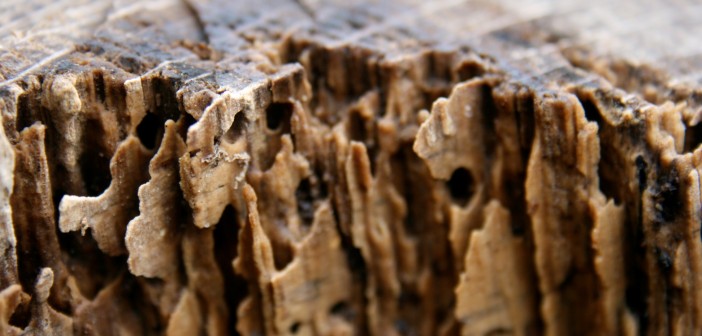In tropical climates, the termite’s wood-chewing activities are important to the ecological balance, but inside your home, shed, vacation property, hotel, or business property, they are unwelcome guests. In fact one 2008 report by the Chicago Tribune cited them as responsible for five billion dollars in property damage- damage not normally covered by your insurance. At a time when the price of wood is hovering at alarmingly high levels, the last thing you want to find out is that you didn’t catch the termites before it was too late.
How termite society causes problems for home owners
The termite is a social insect with a number of habits detrimental to your home and that make this insect difficult to detect and to rid yourself of. The cellulose in wood is their main, though not only, food source- and wood is probably what much of your house is constructed from. Queen termites are very fertile and can keep on laying eggs for many years. King termites don’t die off quick like in ant society, they stay and help the reproduction to continue. A queen gets so filled with eggs that she cannot move freely and assistant termites come to her aid. Tens of thousands of eggs can be laid by only one queen. The workers have micro-organisms in their stomachs that allow them to digest wood into use-able food, which they then share with other termites who can concentrate on other jobs, including making more termites. This is a recipe for a population explosion! If left unchecked, termites can destroy a home in only a few years, and unless you detect them and stop them, it could be too late.
Detection of termite presence
Called the “silent destroyers” because they steer clear of view, one will need to look for tell-tale signs of termites. If you lived on the African plains, you could find them by the huge mounds they would leave in your yard, but in North America and other parts of the world, their work is more subtle. Look for their tunnels creeping up out of the soil by your foundation, for discarded termite wings in your window sills, for holes in your trim, for buckling wood panels, for sagging floors, and for trails of termite feces. Go to your basement and tap and stab wooden beams to see if they are hollow. Also smell for the mildew-ish scent termites are famous for. If found, determine if they are subterranean or dry wood termites. Subterranean will live in the soil and in wood, while dry wood termites only live in wood.
Extermination of termites
If you have an infestation, you can start by soaking cardboard in water and burying it in the soil where termites seem to be near. This is for subterranean species only. Then remove the cardboard with, hopefully, hundreds of termites and burn it. You can do this several times for a short-term fix, reducing their population. According to Watts Pest Prevention, another trick is to buy beneficial nematodes, which are natural termite-killing parasites, and put them where the termites are located to kill off many of them. Sometimes digging a trench and poisoning the soil where subterraneans are entering can work, but beware of the side effects the poison may have on other animals. Boric acid baits and dusts are effective in eliminating termite colonies, but it is difficult to find just where to put the poison, and so a professional exterminator may be needed.
Prevention of termite infestation
To prevent infestation, there are a number of precautionary steps to take. Loos, damp soil should be removed or dried up, and wood should be kept off the ground and away from contact with the house. Gutters and downspouts will need to be cleaned out. Termites thrive on wet wood, and so just remember to remove both wood and water from up against or very near your foundation. Next you should caulk over any cracks, gaps, or holes where termites might enter. Additionally, you may wish to have outside wood treated and to set up barriers of poisoned soil, concrete, metal, etc. to keep termites out or at least expose them when they are forced to build tunnels out in the open before entering your home. Lastly, it should be mentioned that a yearly termite inspection by a professional would help.




